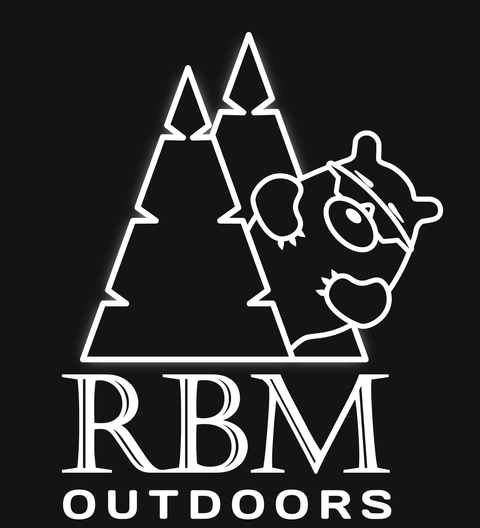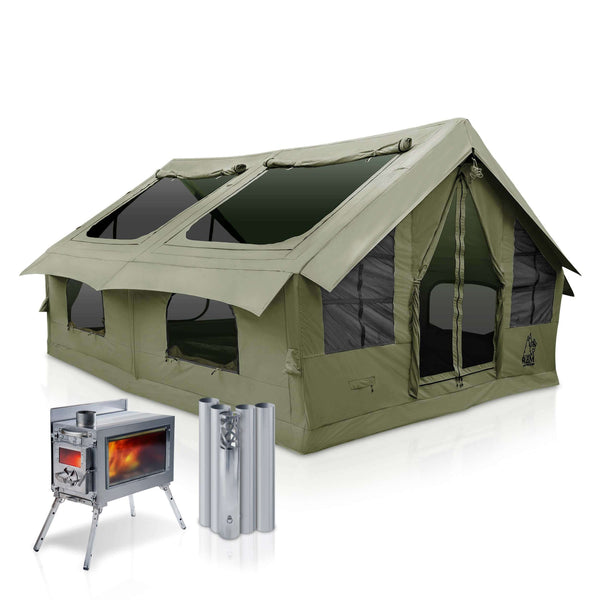Tired of waking up to dripping walls inside your tent? Condensation is a common but frustrating issue that can turn a peaceful camping trip into a damp, uncomfortable experience. This guide explains exactly how to keep the inside of your tent dry, especially in cold or humid conditions. It covers everything from choosing the right tent (like a breathable double-wall or canvas model) to picking the perfect campsite, maximizing ventilation, minimizing internal moisture sources like wet gear and cooking steam, and even using tools like tent dehumidifiers or wood-burning stoves to reduce humidity. With these actionable tips, you’ll sleep dry and comfortable—no matter what the weather throws at you.
Don't want to read? Listen to our podcast!
Contents
Chilling in a tent during a rainstorm is something out of this world. This is one of the most peaceful experiences you can ever have, indeed. However, when the drips appear inside the tent, it’s not that good. No matter how hard you work to waterproof your wildlife shelter, it won’t help if the drips are caused by condensation. It goes without saying that condensation inside tent can spoil your camping trip, and you don't want that, right? If you want to know how to prevent it, stay with us. In this guide, we’ll teach you a couple of actionable tips on how to stop condensation in a tent.
Tent Condensation Explained
Before you learn some secrets about how to reduce condensation in a tent, it’s worth getting to know what causes tent condensation, right? In a nutshell, condensation is the conversion of a vapor or gas to a liquid, which happens when the air temperature falls to the dew point and below. When humid warm air inside the tent meets a cold surface (your tent wall in our case), water collects as droplets on it. The moisture beads up and eventually drops into your tent. Actually, it’s the same process that takes place when we’re having a shower, and the steam makes the mirror in the bathroom wet.
You might wonder how vapor appears inside the tent, and the answer is simple: the single greatest source of condensation is our breath. It sounds strange, but each of us exhales about a whopping 1 liter of water as we sleep at night.
When Does Tent Condensation Occur?
Unfortunately, condensation can appear even in the best tents on the market, and it’s hardly possible to find a tent that will work in each and every situation. So what conditions are most likely to cause condensation? As a rule, condensation typically appears:
- On clear, still, cold night
- In wet rainy conditions, with no wind, and night time temperature drops
- After afternoon rain, with a clear, still cold night
How To Prevent Condensation in a Tent
Although it’s impossible to entirely stop condensation, there are ways to significantly reduce it.
Choose the right tent
Check out our products and choose the best for your camp!
Some tents perform better than others in high condensation environments. Double wall tents are better at dealing with condensation than single wall tents as they allow condensation to pass through the mesh inner and collect on the rainfly instead. When the condensation accumulates, it rolls down the rainfly and onto the ground. On the flip side, single wall tents are likely to trap greater amounts of humidity inside, which leads to higher levels of condensation.
While choosing a tent for your first camping trip, pick one that offers the maximum amount of ventilation.
Also, consider outfitter tents made from breathable cotton canvas. It will not only help you prevent condensation, but also keep you cool on warm days and insulated in the cold season.

Pitch your tent in the right place
The place you set up your shelter really matters. To prevent condensation, pitch your tent on dry ground. If it’s possible, put up your wildlife shelter under trees: air under trees is warmer than in an open area, which reduces chances for moisture in the humid air to condensate inside your tent. Set up the entrance of the tent into the wind to provide for increased airflow in and around the tent. It’s a good idea to use a tent footprint or ground sheet to prevent moisture coming up from the ground.
Also, avoid setting up your shelter too close to lakes, rivers, ponds, creeks, and marshland where the humidity is higher. Remember that low-lying valleys are likely to collect cold air and have more ground moisture because of the lack of airflow. That’s why it’s better to go for higher points with warmer temperatures and better airflow.
Ventilate your tent
Without any doubt, ventilation is your best friend if you seek to prevent condensation. Air inside the tent always has higher humidity levels than air outside. Tents are produced from waterproof fabrics that trap moisture inside the tent. To get the humid air out, you need to ventilate your tent. Consider the following ventilation strategies that will help you reduce condensation.
- As we’ve already mentioned, it’s a good idea to pitch the tent so the door is facing the breeze.
- Open all tent windows.
- Maximize the airspace between the rain fly and the wall of the tent.
- Open all fly doors and use them only when the rain starts.
- Open up all fly vents.
- Make sure that none of the vents or doors is blocked by the sleepers or their gear.
Minimize sources of moisture
If you strive to reduce condensation in your tent, it’s important to know that moisture in tents can come from the following sources:
- The existing air humidity.
- Extra moisture added by your breathing.
- Moisture added by any wet things like wet clothes or sleeping bags.
- Cooking inside the tent.
You can do nothing to change air humidity, and not breathing isn’t an option either. However, you’re in total control over whether you bring wet gear into the tent. To prevent condensation, you need to dry your gear out during the day. If that’s not possible, keep your damp hiking boots, clothes and backpacks in the vestibule at night. And yes, cooking inside is a taboo if your goal is to get rid of condensation in a tent. Apart from being unsafe, cooking creates large vapor volumes.

Finally, don’t forget to thoroughly dry your sleeping bag. While you’re sleeping, your bag will get wet and that moisture will evaporate and condense on the tent’s walls.
Wipe the tent inside
Since it’s impossible to entirely keep condensation away, remember to pack a microfiber or a towel to wipe down the tent walls any time you notice they’re a touch damp.
Use a tent dehumidifier
A tent dehumidifier is a reasonable solution for small tents. The device can help reduce the amount of moisture buildup in the air inside of the tent. However, using a dehumidifier doesn’t mean that you can forget the basics of reducing condensation. It’s good to combine the above mentioned traditional methods and a dehumidifier to achieve the best results.
How To Prevent Condensation in a Tent During Winter

As you already know, if the inside of your tent is warmer than the outside, it creates perfect conditions for moisture to accumulate and condensation to occur. And this is not how you dream to wake up on a winter morning, right? In fact, you can use previously mentioned tips to prevent condensation in your tent during winter camping.
Also, consider using tent wood stoves that provide a dry heat, which allows condensation to vaporize. Your task is to open the door and let the humid air escape. What is more, wood stoves are your best friends if you need to quickly dry out your wet gear, removing another source of humidity. In the winter, the inside canopy is frequently frosted in the morning from water vapor expelled through breathing. A stove can quickly melt and vaporize this frost.

Why Is Tent Condensation Bad?
Apart from those unpleasant drops dripping from your tent walls, condensation in the tent can lead to other negative consequences. First of all, dampness in the tent can affect the quality of perishable goods. What is more, it is very likely to cause mould buildup, making your tent dangerous for your health.
FAQ
🏕 Does condensation occurrence depend on your tent?
- Yes. If you want to experience less condensation, pick a tent that features several entrances and windows for more efficient ventilation. Remember that bigger and higher doors let more air in and out. In addition, consider a tent with vertical walls, known as an outfitter or wall tent. This means that you won’t touch the fabric inner or breathe straight onto the fabric, and you and your gear won’t get wet from condensation.
📦 Does a footprint help to prevent condensation?
- Sure. By using a footprint, you minimize condensation inside the tent through protecting it from moisture that comes from the ground. If you are going to camp in humid climates, we recommend using a footprint. If you have an older tent that has lost some of its water-resistance, the footprint can help increase comfort and prevent moisture inside the tent.
💡 What kind of weather is likely to make tent condensation worse?
- Condensation tends to get worse when the air outside is substantially cooler than inside, after a warm day in particular. Rainy conditions are also very likely to multiply the chances of condensation to spoil your vacation. Rain water makes the temperature of the tent fabric drop, which results in a faster condensation process.


 Air Tents
Air Tents Coody 17.2 Inflatable Tent
Coody 17.2 Inflatable Tent ALL SEASON TENTS
ALL SEASON TENTS Cold Weather Tents with Stoves
Cold Weather Tents with Stoves Tent Stoves
Tent Stoves Tent Accessories
Tent Accessories





Comments
Shelly Squires said:
I never understood why tent condensation happens… Thankfully now I do
Robert Muir said:
It’s a real issue, thanks for covering it
Mischa May said:
Throughout my camping years I have realized the importance of ventilation
Kenneth Burgess said:
Can anyone suggest a good camping fan for ventilation?
Glen Daugherty said:
They actually sell one on this website. Try checking the ‘accessories’ section